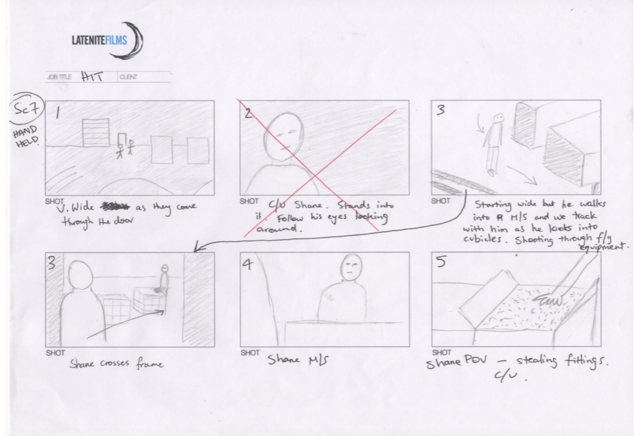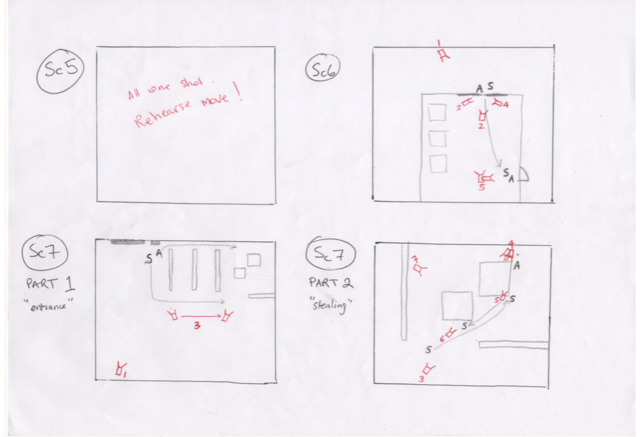The most important (and neglected) aspect of directing…
Firstly I want to preface everything hereafter by saying that I’m not a director with decades of experience and countless awards to my name. I’m not in super high demand and I can assure you I’m not earning the big bucks. I’m relatively new…. ‘emerging’ as we like to call it. I still have a lot to learn and a long way to go to be able to eventually make the things I want to. But I will share with you something that I feel quite strongly about through my experiences so far. Something that I have noticed is often neglected, but is without doubt the single most important tool in the director’s arsenal – blocking.
So let’s very quickly go back to basics – what does a director actually do? To many outside the industry, the thought of a director instantly conjures up images of a Hollywood studio backlot in the 1930’s with a man smoking a cigar in a chair yelling orders through a megaphone. At a recent catch up with some very distant (and slightly intoxicated) friends, I had a conversation which seems to be a recurring dialogue with people I meet. I’d be surprised if many directors haven’t had this conversation at least once:
Friend: So what do you do these days?
Me: I’m a director.
Friend: That’s so exciting! Hey guys, come over here, this guy’s producing movies!” Me: Actually I’m a director. Producers are different.
Friend: Oh right, sorry I mean a director. Who’s higher – a director or a producer?
People seem fascinated with who is higher up the pecking order…and strangely enough it’s not such a simple question to answer. The reality is, not many people know too much about what a director actually does and after spending half the night explaining the roles, next time you see them, the question is generally the same, “How’s the film producing thing going?”.
Anyway, I digress.
Simply put, I’ve often heard that the two key things a director is responsible for once on set are ‘working with actors’ and ‘camera positioning’. These are definitely crucial aspects to capturing the scene. But what often comes as a bit of an afterthought and placed with a lot less significance is that of blocking.

Blocking is essentially the placement and movement of your cast through the space. To me, this is the MOST important responsibility of a director and should be so carefully thought out and considered. Because really, there is no right and wrong and there are an infinite amount of ways the scene can be blocked out. It’s the responsibility of the director, to come up with the best way to do it.
Why is this so important? Well it effects EVERYTHING! Your coverage is totally dependant on how the scene is blocked. Who is where? Where do they move? When do they move? I recently was lucky enough to sit down and have a chat with a vastly experienced TV director. It was interesting to hear him talk about splitting scenes into three categories – A, B and C. ‘A’ scenes were ones that were so important that there was no room for compromise. Think of a huge war scene that completes a series – it’s an integral part of the story and the full amount of time should be allocated to it and no shots can afford to be dropped. Full stop. Even if it means going into overtime despite the pressure from the 1st AD and producers. As he put it, “no producer has ever complained in the edit room when the scene is amazing. Only when there was a key shot missing because you were forced to cut it!” So ‘A’ scenes warrant a ‘no compromise’ attitude.

‘B’ and ‘C’ scenes are more relevant to what I’m about to explain regarding blocking. They are a little less important to the overall story and if push comes to shove (e.g – it’s 1630, you’re an hour down and you’re getting death stares from the 1st who’s chewing gum at a frantic pace!) we can afford to drop a shot or two with the knowledge that the scene will still cut together fine.
Let’s take a short 20 second scene that involves 2 characters giving some exposition. It’s not going to make or break your show. For the purpose of this example, let’s say there’s no dolly, it’s all handheld. The scene is written that they are walking down a corridor and then one stops and turns to face the other when something important is said. An obvious way to cover this, would be:
• Wide master
• 2 shot as they walk
• 2 x singles once they’ve stopped
4 shots.
Ok, now assuming you trust your actors are solid and you will not need to ‘cut around’ performance, and you believe that they can give you the reaction to the important dialogue without the need to stop, then let’s make it a single shotter. How do you do this? Change the blocking! Let’s have them continue walking and not stop. You may have just dropped the 1st’s bp by about 50!
This is a very simple example but you can imagine how much of an impact blocking has on your coverage in a more complex scene. Where you place your actors will determine how many shots you will need. If you place them apart, you will need two singles, if you have them together you may be able to get away with a 2 shot. I’m certainly not saying that you should always try to cut out shots, but highlighting that where you place the actors fully determines what shots you will need. This may seem obvious, but the amount of times I’ve seen directors unable to drop any shots because they absolutely need them all to make the scene work. But if they rethought the blocking, it may make the coverage a lot easier.

So the correlation between blocking and coverage is quite clear as it should be to most. But what about the way blocking affects working with actors? This is just as important. I know that as a director, there are quite often situations where on the day, scenes are just not working. Actors can often say to you that something just doesn’t feel right. Hopefully it’s obvious pretty early on in the first rehearsal that the actor is uncomfortable with how the scene is playing out. Otherwise it’s obvious in the edit and then it’s too late!! It’s so common to look at the script for the answer. Maybe if we lose this line, or change that line the character may come more naturally. Sometimes though this doesn’t work and it’s not a dialogue issue at all no matter how hard we search.
Let’s make up another scene – a husband and wife argue in the kitchen. The wife sits at the table and the husband walks into the room, stands by the sink and then they begin to fight. The actors have rehearsed it over and over and it just doesn’t feel right to either of them. As a collective we have reviewed every piece of dialogue and changed words into what feels more fitting. But after a couple of rehearsals, we’re still not nailing it. Let’s review the blocking. How about if the husband is sitting at the table, and the wife walks in and goes over to the sink. YES! All of a sudden, something as simple as switching the positions has changed the whole dynamic of the scene. The actors now feel so much more comfortable and natural in the characters. It sounds so strange, but the positioning of the actors in the space can have such a HUGE effect on how the character comes through. Body language, movement, interaction – it’s all so important for the actor, and it’s all blocking.
I think it’s also so important to have an open communication with your actors about it too. Using the same example above, I might ask the male actor if he feels like the husband should stand up when the conversation becomes heated and maybe walk over to the wife. The actors know their character motivation better than anyone and I think it’s great to ask and see how they feel. He might say no, because he feels that he has done wrong so is submissive at this point in the story and she finally has the upper hand on him so it feels more real that he stays seated and keeps his distance. Great!
I have found that a huge part of directing is empowering those around you. In addition to working with the actors, it’s also great to work with your dp on the blocking and most importantly – be flexible. Naturally, you will plan your blocking in pre and then go over it the night before to understand where the characters need to be and at what point, but I think it’s such a strength if you are able to give them parameters rather than rules. Time permitting, it’s so great to be able to step onto set with your actors and dp with only a couple of key pointers (ie. In the last scene the character arrives in the driveway, so therefore they must enter the front door) but letting your actors naturally move through the space and work out blocking for themselves. Then measuring that against how you imagined the blocking and see what’s stronger and how it feels. Workshopping like this may take a bit more time initially, but may save later on by not reaching the unnecessary point of “it doesn’t feel right”. It also gives your dp a chance to feel out the scene and make some very important suggestions.
Clearly blocking plays a massive role and it’s nice to be able to share my two cents about something that I’ve recently learnt myself as a director. Now, I always try to pay special attention to every possible scenario of blocking, taking into account all of the things listed above. It’s certainly helped me immensely.
So what is blocking? Well to me it is the convergence of working with the actor and positioning the camera. It’s the first thing that must be thought up, which then determines everything else. So next time you’re under the pump to work quicker or your actors just don’t feel right, take a closer look at something that is often forgotten….blocking.
Anyway, I’m off to go produce….uh….I mean direct!